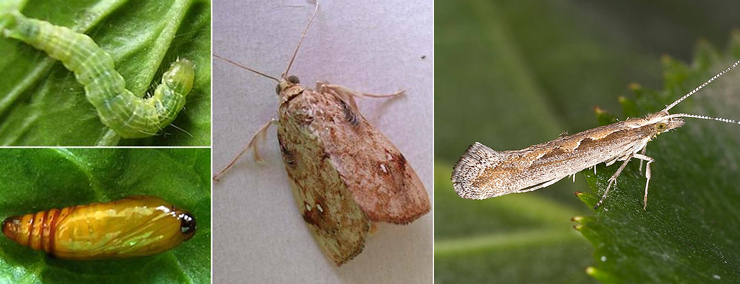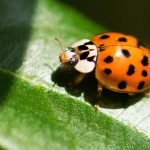
Land Cress (Barbarea vulgaris and Barbarea verna) releases chemicals which attract the Diamondback Moth (right) and the Large Cabbage Moth (left) – both small brown moths which are common pests in the vegie garden. These moths lay their eggs in the Land Cress, subsequently the emerging caterpillars feed on the Land Cress, are poisoned by the saponins in the leaves and die. So if you hear Land Cress referred to as a ‘Dead End Trap Crop’ – that is why.
Also worth noting is Land Cress – Barbera verna – is a nice spicy addition to salads.
Do NOT confuse Diamond Moth and Large Cabbage Moth with the Cabbage White Butterfly. Confusion of these names has led to an unsubstantiated belief that Land Cress is a Dead End Trap Crop for the Cabbage White Butterfly (Pieris rapae). Landcress attracts the butterfly, but does not kill its caterpillars. You can use it to trap the caterpillars, then pull the plant out and bin plant and pests. Alternatively, once you have a nice infestation building up on your land cress you can give it a spray with Dipel, hopefully breaking the pest infestation cycle without having to spray the vegies.
The back story:
A plant that can attract and kill pest caterpillars almost sounds too good to be true. Well for an unfortunate number of caterpillar species it is a reality and the plant is commonly known as Land Cress (Barbarea vulgaris)
Land Cress (Barbarea vulgaris) can be used as a dead end trap crop for two common brassica pest caterpillars, the Diamondback Moth (Plutella xylostella) and Large Cabbage Moth (Crocidolomia pavonana).
They way it works is quite amazing, the plant releases chemical substances called glucosinolates which attracts the pests to lay their eggs on the plant. When the eggs hatch, the young caterpillars eat the leaves which contain soap-like compounds called saponins, and then die.
‘Land Cress’ is a common name used to describe both Barbarea vulgaris and Barbarea verna. Even though Barbarea vulgaris does contain a higher levels of the toxin both varieties, both Barbarea vulgaris and Barbarea verna have been proven to work as dead end trap crops.
If you’re after a more scientific reassurance, the research article published in PubMed in Feb 2014 [2] with the lengthy title of “Using plant chemistry and insect preference to study the potential of Barbarea (Brassicaceae) as a dead-end trap crop for diamondback moth (Lepidoptera: Plutellidae)” states:
“Barbarea plants were also assessed based on the criteria of high content of glucosinolates, which stimulate adult oviposition and larval feeding in P. xylostella, and high content of saponins, which are detrimental to survival of P. xylostella larvae. All Barbarea plants tested were preferred over cabbage by ovipositing P. xylostella”.
Put simply, all species of Barbarea attract the pests to lay their eggs on them.
“Despite containing a lower content of saponins than other Barbarea plants tested, Barbarea verna did not allow survival of P. xylostella larvae. Our studies show that, except for B. rupicola and P-type B. vulgaris var. arcuata, which allowed survival of P. xylostella larvae, all Barbarea plants tested have potential as dead-end trap crops for P. xylostella.”
The article concludes that although Barbarea verna has lower levels of the saponins that kill the caterpillars, it has enough to kill them with a 100% success rate, and all Barbarea species except for two (which are not the ones in question) work as dead end trap crops.
References:
[1] http://jerry-coleby-williams.net/2014/11/01/nannys-cabbage-companion-confirmed-caterpillar-killer-by-university-of-queensland/
[2] Badenes-Perez FR, Reichelt M, Gershenzon J, Heckel DG (2014) Using plant chemistry and insect preference to study the potential of Barbarea (Brassicaceae) as a dead-end trap crop for diamondback moth (Lepidoptera: Plutellidae). Phytochemistry: 137–144. [PubMed]
Pictures by Olaf Leillinger, G McCormack and T.K. Crosby


